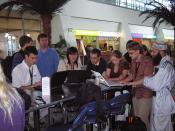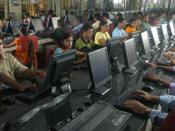A national survey of college students taken by Pew Research in the United States has found some startling information about the gender gap in the computing field. According to RECENT surveys, 77.8 percent of women and 79.5 percent of men report frequent computer use. However only 1.8 percent of women compared to 9.3 percent of men see computer programming as a future career.
The field of computing has been and still is a predominantly male field. Even with the progress towards equality that most fields have achieved, women today receive less than twenty-eight percent of the computer science bachelors degrees. This means significantly fewer women are entering the computing workplace than are their male counterparts. What's worse is that the number of women getting these degrees is actually decreasing. We must take steps in order to include more women in this predominantly male field. Many stereotypes about computer related jobs need to be wiped from society and women need to be able to feel comfortable entering a field where the majority of their counterparts are male.
I feel that there are a few excellent ways we can approach this problem and that the best solution lies in encouraging girls at a young age.
It is common knowledge that women are better with tasks involving fine motor skills and men are generally better with tasks involving large motor skills. It only makes logical sense, with computer programming being such a detail-oriented task, to make an effort to include women. Combining the fine motor skills of women with the large motor skills of men would create outstanding programming teams. In order to then solve this problem we need to focus on women while they are at the early years of high school. Girls make up only 17 percent of those who take computer science advanced placement tests in high school. Looking locally at my current advanced computer course, we see that of a class of about thirty there are only two females present. With computers becoming a necessary part of our lives, perhaps the first step would be to make at least one computers class compulsory in high school. Although forcing girls into computers does not solve the problem over the long-term, it allows for equal class sizes at the younger age. Equal class sizes means that the initial intimidation girls would face when entering a class of all males would disappears at a younger ages. With the intimidation factor solved by equal class sizes, girls can then see computers in a different light, not just as something in which only boys are involved. Hopefully, this will make computers an option for many girls who were before too intimidated to even consider computers as a career. Making the course necessary is also beneficial to both sexes. Computers are just as much a part of our society as other pre-requisite courses such as business and social science. It makes sense to include computers in this group.
Once we have opened the doors for girls to consider the computing field we then need to then further attract women to the post-secondary level. Universities and colleges need to make a valid effort to rid the stereotype of the anti-social male 'nerd' and entice women into the field. Pamphlets and brochures need to make an effort to include an equal number of women and men. Perhaps at conferences and school visits universities need to specifically send female representatives enrolled in the computer science course. Allowing students to interact with someone who defies the stereotype of an anti-social male 'nerd' will interest more women into considering computer science as a degree. Another idea is to hold female-specific computer competitions in which females compete in the area of computers for scholarships. Competitions geared towards this specific group would give females good reason to consider programming and will show them that the universities feel the female applicants are just as important as the male applicants. If done correctly, competitions like this also make other high school and college students aware that women are an important part of the field.
With time, these initiatives should have a compounding effect. More women in the computing workplace means the stereotype would eventually disappear. With more women involved in the computing workplace, more video games made by females for females should appear. Eventually, computers will be seen as a unisex device, with an equal number of men and women in the computer science workplace.
Time is the key to the solution. In our society, which strives to become more equal with every passing day, the solution lies in time and effort. This is a problem that could possibly take a decade to solve and so we must be patient. The important thing is that we make sure we make a notable effort to include women in the workplace. As long as we put forth effort then we have succeeded, the rest is up to time.





